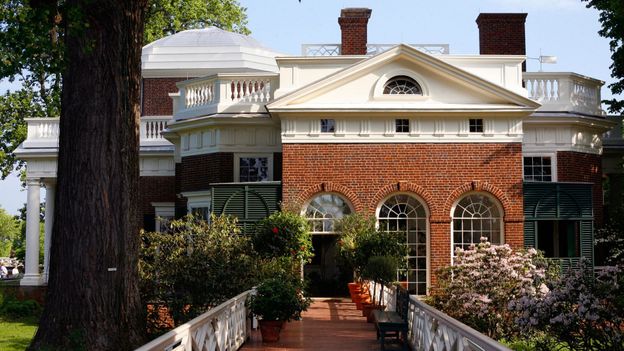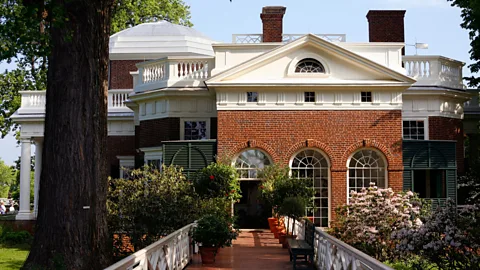
A Jeffersonian-style tour of Charlottesville
[ad_1]

Recently named America’s brainiest city, the thriving academic culture that former US president Thomas Jefferson cultivated in his Virginia home still lives on today.
Thomas
Jefferson, one of the United States’ founding fathers, believed that learning
should be a lifelong pursuit. In addition to authoring the Declaration
of Independence and serving as the young country’s third president, he was
also a philosopher, an inventor, an architect, a student of agricultural
sciences and an avid reader, accumulating the country’s largest personal
collection of books (nearly 7,000). One of his proudest accomplishments was the
creation of the Academical Village, the first
iteration of the
University of Virginia (UVA), an entirely secular university that was built
around the centrepiece of a library rather than a church. It was a place where the
vibrant exchange of ideas between students and professors was a part of
everyday life.
This thriving
academic culture lives on today in Charlottesville, Virginia — the town Jefferson
once called home — and its residents are living up to his legacy of
intellectualism. According to the US-based Atlantic magazine, a 2012 study of
US metropolitan areas found Charlottesville to be the country’s brainiest city.
Whether
Charlottesville is truly the smartest city in the US is, naturally, up for
debate (something Jefferson was very much in favour of). Either way, visitors
to this beautiful town will find many opportunities for intellectual travel — thought-provoking
enough to make the founding father proud.
Strolling
around the historic downtown area, you are bound to notice a surprising number
of charming, independent bookstores. (In fact, the town was ranked the fourth best city for book lovers in the US last year by Livability, a website focused on city rankings).
On Main Street, a large industrial warehouse has been converted into Random
Row Books, a fantastic
bookshop specialising in rare, uncommon and used books. Outside, a massive
mural of a Native American chief hints at the artistic vibe in the shop, which
you enter through an open garage door. With an interior of exposed brick and
eclectic furniture, it is no wonder that Random Row doubles as an event space,
hosting concerts, film screenings, lectures and art exhibits in the evenings
Along the downtown mall, visitors can soak in more art during First Fridays, a free gallery-hopping
event found in many US cities where the public can view new exhibitions while
sipping complimentary wine and nibbling gratis cheese on the first Friday of
each month. If you happen to miss it, opt for a more unique experience at the Kluge-Ruhe Aboriginal Art Collection, one of the few museums in the US dedicated to Australian
Aboriginal art. Following Jefferson’s philosophy, Kluge-Ruhe offers “Lifelong Learner” opportunities for adults
interested in attending lectures or taking courses in Aboriginal art.
Part of UVA, the free museum is hosting a fascinating exhibition called Past Forward through July 2013, which showcases contemporary
Aboriginal artists depicting themes of identity, history and place. One painting by
Australian artist Munggurrawuy
Yunupingu depicts the first moon landing, portraying US astronauts Neil
Armstrong and Buzz Aldrin using the geometric shapes and figures found in
traditional Aboriginal bark paintings.
Further astronomical exploration can be embarked upon at the McCormick Observatory, also part of
UVA’s campus. On the first and third Friday of each month, astronomy
enthusiasts can tour the normally closed-to-the-public facility, learn about
their research and view the stars and planets through the university’s powerful telescopes.
If travelling
with kids, you have the perfect excuse to visit the Virginia
Discovery Museum, which features an ongoing exhibition on bees with a bee hive and
pollination station. Also good for children, the Lewis and
Clark Exploratory Center, located on the bank of the Rivanna River, is running boat tours to
help raise funds for the still under-construction building, which does not have
a set date for completion. The guided tours take in docked replicas of the ships
that explorers Meriwether Lewis and William Clark travelled in as they headed west
along the Missouri River. Lewis grew up in the Charlottesville area, and Clark’s
family lived near the site of the exploratory centre for several years. When
the centre opens, it will offer guided nature walks, kayaking trips and a
boat-building centre for kids.
Conclude your
trip by following Jefferson’s own intellectual path. A self-taught architect,
two of his designs, his home of Monticello
and his UVA Academical Village, were just named 2012 World Wonders by National Geographic
Traveler. On the scenic five mile drive to Monticello, a 5,000-acre plantation atop
Monticello Mountain, listen to the radio show (or podcast) The
Thomas Jefferson Hour, a weekly conversation where the humanities scholar Clay Jenkinson assumes
the role of the founding father and addresses modern issues through the lens of
Jeffersonian thinking.
When you
arrive, begin by exploring the gardens. Agriculture, Jefferson said, “is a science of the very first order”. His
reverence for agricultural sciences and botany is evident in the vegetable
gardens; the apple, peach and grape orchards; the historic plants greenhouse;
and the flower gardens that feature dozens of species. History is Monticello’s main selling
point though, and the plantation offers several interesting tours. The Slavery at Monticello Tour takes a hard look at the
people who worked on the plantation and their struggles. Wrap up your day at
the visitor’s centre, which features an architecture exhibit
and an exhibit explaining how Jefferson used Monticello as a laboratory for
learning.
[ad_2]
Source link





